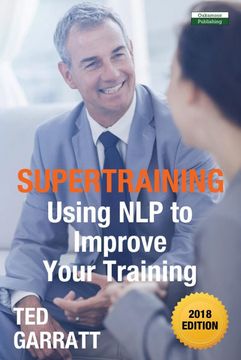Reseña del libro "Supertraining: Using nlp to Improve Your Training (en Inglés)"
Neuro-Linguistic Programming – commonly known as NLP – is a method of communication and engagement used widely in the world of business, sport, and personal-development training.In SuperTraining, join one of the UK’s leading trainers – Ted Garratt – as he covers more than 60 NLP techniques and approaches, including: Anchors, Reframing, Creating Rapport, Sleight of Mouth, Non-Verbal Communication, Future Pacing, Matching, and more. This book will help trainers to engage with, and develop, their participants better than ever before.Designed to be a dip-in practical resource, rather than read cover to cover, this book will aid trainers and readers who have a rudimentary understanding of NLP, but it will also benefit complete novices who want to learn about NLP and how it can help them; instructions for implementing the various techniques, alongside case studies and key points, are all included.This is a revisited edition of the original book – The Effective Delivery of Training Using N.L.P.: A Handbook of Tools, Techniques and Practical Exercises.Table of ContentsSection 1. Creating the right environment * Styles of training | Creating rapport | Creating and maintaining high expectations | Creating rituals and engaging emotions | Using exercise bursts to create energy | Acknowledging different learner stylesSection 2. Creating an effective personal state * Maintaining a positive personal state | Creating personal flexibility | Being a learning trainer | Behaviour modelling and strategies | Setting own personal outcomes | Using anchors | Using perceptual positions | Using a variety of training techniques | Using context as well as content clues | Using the big picture/little picture technique | Understanding brain hemisphere functions | Using calibration | Using congruence | Using association/disassociation Section 3. Getting the message across * Using language patterns | Using metaphors | Using reframing | Using backtracking | Using sleight of mouth | Using quotes | Using embedded commands | Using relevancy challenges | Gathering information | Communicating clearly and effectively | Using pre-suppositions | Using effective questions | Using eye accessing cues |Section 4. Being flexible to meet the needs * Getting participants to set own goals | Pacing and leading a group | Using non-verbal communication | Creating group dynamics | Changing learner states | Using humour | Switching roles and styles | Being aware of invisibles (values, beliefs, identity) | Creating reference experiences | Creating new learning patterns | Noticing behavioural changes | Using effective feedback | Unsticking people | Using reverse tests | Maintaining involvement | Instructing people | Creating positive beliefs | Accelerated learning | Using timelines | Using future pacing | Using meta programs | Tasking people | Using chunking | Using sub-modalities | Using memory techniques | Using present state - desired state | Using edits | Using the new behaviour generator | Using internal dialogueSection 5. Confirming the learning * Revising objectives | Agreeing action plans | Using checklists | Effective endings | Post-course self-evaluation | Learning for next timeGlossary of terms

